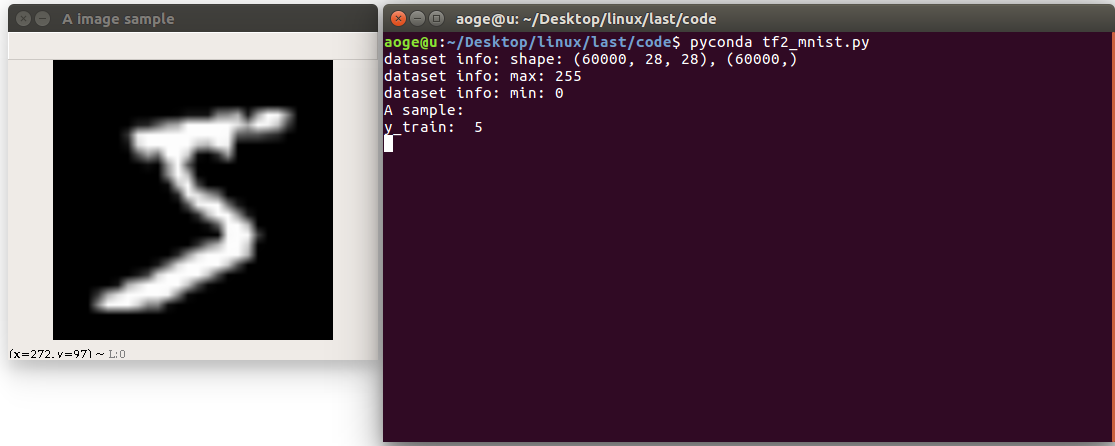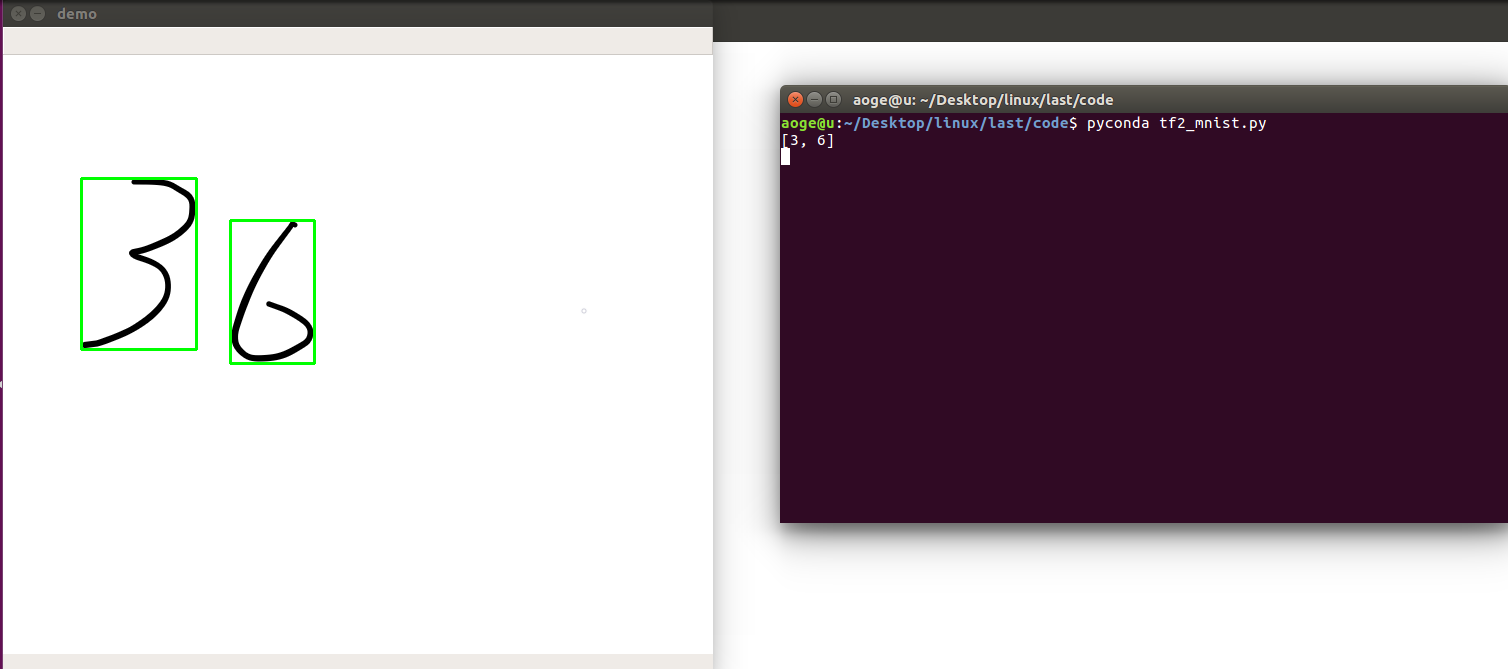linux-基于tensorflow2.x的手写数字识别-基于MNIST数据集
数据集
数据集下载MNIST
首先读取数据集, 并打印相关信息
包括
- 图像的数量, 形状
- 像素的最大, 最小值
- 以及看一下第一张图片
path = 'MNIST/mnist.npz'
with np.load(path, allow_pickle=True) as f:
x_train, y_train = f['x_train'], f['y_train']
x_test, y_test = f['x_test'], f['y_test']
print(f'dataset info: shape: {x_train.shape}, {y_train.shape}')
print(f'dataset info: max: {x_train.max()}')
print(f'dataset info: min: {x_train.min()}')
print("A sample:")
print("y_train: ", y_train[0])
# print("x_train: \n", x_train[0])
show_pic = x_train[0].copy()
show_pic = cv2.resize(show_pic, (28 * 10, 28 * 10))
cv2.imshow("A image sample", show_pic)
key = cv2.waitKey(0)
# 按 q 退出
if key == ord('q'):
cv2.destroyAllWindows()
print("show demo over")

转换为tf 数据集的格式, 并进行归一化
# convert to tf tensor
x_train = tf.convert_to_tensor(x_train, dtype=tf.float32) // 255.
x_test = tf.convert_to_tensor(x_test, dtype=tf.float32) // 255.
dataset_train = tf.data.Dataset.from_tensor_slices((x_train, y_train))
dataset_train = dataset_train.batch(batch_size).repeat(class_num)
定义网络
在这里定义一个简单的全连接网络
def build_simple_net():
net = Sequential([
layers.Dense(256, activation='relu'),
layers.Dense(256, activation='relu'),
layers.Dense(256, activation='relu'),
layers.Dense(class_num)
])
net.build(input_shape=(None, 28 * 28))
# net.summary()
return net
训练
使用 SGD 优化器进行训练
def train(print_info_step=250):
net = build_simple_net()
# 优化器
optimizer = optimizers.SGD(lr=0.01)
# 计算准确率
acc = metrics.Accuracy()
for step, (x, y) in enumerate(dataset_train):
with tf.GradientTape() as tape:
# [b, 28, 28] => [b, 784]
x = tf.reshape(x, (-1, 28 * 28))
# [b, 784] => [b, 10]
out = net(x)
# [b] => [b, 10]
y_onehot = tf.one_hot(y, depth=class_num)
# [b, 10]
loss = tf.square(out - y_onehot)
# [b]
loss = tf.reduce_sum(loss) / batch_size
# 反向传播
acc.update_state(tf.argmax(out, axis=1), y)
grads = tape.gradient(loss, net.trainable_variables)
optimizer.apply_gradients(zip(grads, net.trainable_variables))
if acc.result() >= 0.90:
net.save_weights(save_path)
print(f'final acc: {acc.result()}, total step: {step}')
break
if step % print_info_step == 0:
print(f'step: {step}, loss: {loss}, acc: {acc.result().numpy()}')
acc.reset_states()
if step % 500 == 0 and step != 0:
print('save model')
net.save_weights(save_path)
验证
验证在测试集的模型效果, 这里仅取出第一张进行验证
def test_dataset():
net = build_simple_net()
# 加载模型
net.load_weights(save_path)
# 拿到测试集第一张图片
pred_image = x_test[0]
pred_image = tf.reshape(pred_image, (-1, 28 * 28))
pred = net.predict(pred_image)
# print(pred)
print(f'pred: {tf.argmax(pred, axis=1).numpy()}, label: {y_test[0]}')

应用
分割手写数字, 并进行逐一识别
- 先将图像二值化
- 找到轮廓
- 得到数字的坐标
- 转为模型的需要的输入格式, 并进行识别
- 显示
def split_number(img):
result = []
net = build_simple_net()
# 加载模型
net.load_weights(save_path)
image = cv2.cvtColor(img.copy(), cv2.COLOR_RGB2GRAY)
ret, thresh = cv2.threshold(image, 127, 255, 0)
contours, hierarchy = cv2.findContours(thresh, 1, 2)
for cnt in contours[:-1]:
x, y, w, h = cv2.boundingRect(cnt)
image = img[y:y+h, x:x+w]
image = cv2.resize(image, (28, 28))
pred_image = tf.convert_to_tensor(image, dtype=tf.float32) / 255.
pred_image = tf.reshape(pred_image, (-1, 28 * 28))
pred = net.predict(pred_image)
out = tf.argmax(pred, axis=1).numpy()
result = [out[0]] + result
img = cv2.rectangle(img, (x, y), (x + w, y + h), (0, 255, 0), 2)
cv2.imshow("demo", img)
print(result)
k = cv2.waitKey(0)
# 按 q 退出
if k == ord('q'):
pass
cv2.destroyAllWindows()
效果
单数字

多数字


附录
所有代码, 文件 tf2_mnist.py
import os
import cv2
import numpy as np
import tensorflow as tf
from tensorflow.keras import layers, Sequential, optimizers, metrics
# 屏蔽通知信息和警告信息
os.environ['TF_CPP_MIN_LOG_LEVEL'] = '2'
# 每批几张图片
batch_size = 2
# 类别数
class_num = 10
# 保存模型的路径
save_path = "./models/mnist.ckpt"
# 展示样例
show_demo = False
# 验证测试集
evaluate_dataset = False
# 是否训练
run_train = False
# 图片路径, 仅用于 detect_image(), 当为False时不识别
image_path = 'images/36.png'
path = 'MNIST/mnist.npz'
with np.load(path, allow_pickle=True) as f:
x_train, y_train = f['x_train'], f['y_train']
x_test, y_test = f['x_test'], f['y_test']
if show_demo:
print(f'dataset info: shape: {x_train.shape}, {y_train.shape}')
print(f'dataset info: max: {x_train.max()}')
print(f'dataset info: min: {x_train.min()}')
print("A sample:")
print("y_train: ", y_train[0])
# print("x_train: \n", x_train[0])
show_pic = x_train[0].copy()
show_pic = cv2.resize(show_pic, (28 * 10, 28 * 10))
cv2.imshow("A image sample", show_pic)
key = cv2.waitKey(0)
if key == ord('q'):
cv2.destroyAllWindows()
print("show demo over")
# convert to tf tensor
x_train = tf.convert_to_tensor(x_train, dtype=tf.float32) // 255.
x_test = tf.convert_to_tensor(x_test, dtype=tf.float32) // 255.
dataset_train = tf.data.Dataset.from_tensor_slices((x_train, y_train))
dataset_train = dataset_train.batch(batch_size).repeat(class_num)
def build_simple_net():
net = Sequential([
layers.Dense(256, activation='relu'),
layers.Dense(256, activation='relu'),
layers.Dense(256, activation='relu'),
layers.Dense(class_num)
])
net.build(input_shape=(None, 28 * 28))
# net.summary()
return net
def train(print_info_step=250):
net = build_simple_net()
# 优化器
optimizer = optimizers.SGD(lr=0.01)
# 计算准确率
acc = metrics.Accuracy()
for step, (x, y) in enumerate(dataset_train):
with tf.GradientTape() as tape:
# [b, 28, 28] => [b, 784]
x = tf.reshape(x, (-1, 28 * 28))
# [b, 784] => [b, 10]
out = net(x)
# [b] => [b, 10]
y_onehot = tf.one_hot(y, depth=class_num)
# [b, 10]
loss = tf.square(out - y_onehot)
# [b]
loss = tf.reduce_sum(loss) / batch_size
# 反向传播
acc.update_state(tf.argmax(out, axis=1), y)
grads = tape.gradient(loss, net.trainable_variables)
optimizer.apply_gradients(zip(grads, net.trainable_variables))
if acc.result() >= 0.90:
net.save_weights(save_path)
print(f'final acc: {acc.result()}, total step: {step}')
break
if step % print_info_step == 0:
print(f'step: {step}, loss: {loss}, acc: {acc.result().numpy()}')
acc.reset_states()
if step % 500 == 0 and step != 0:
print('save model')
net.save_weights(save_path)
def test_dataset():
net = build_simple_net()
# 加载模型
net.load_weights(save_path)
# 拿到测试集第一张图片
pred_image = x_test[0]
pred_image = tf.reshape(pred_image, (-1, 28 * 28))
pred = net.predict(pred_image)
# print(pred)
print(f'pred: {tf.argmax(pred, axis=1).numpy()}, label: {y_test[0]}')
def split_number(img):
result = []
net = build_simple_net()
# 加载模型
net.load_weights(save_path)
image = cv2.cvtColor(img.copy(), cv2.COLOR_RGB2GRAY)
ret, thresh = cv2.threshold(image, 127, 255, 0)
contours, hierarchy = cv2.findContours(thresh, 1, 2)
for cnt in contours[:-1]:
x, y, w, h = cv2.boundingRect(cnt)
image = img[y:y+h, x:x+w]
image = cv2.resize(image, (28, 28))
pred_image = tf.convert_to_tensor(image, dtype=tf.float32) / 255.
pred_image = tf.reshape(pred_image, (-1, 28 * 28))
pred = net.predict(pred_image)
out = tf.argmax(pred, axis=1).numpy()
result = [out[0]] + result
img = cv2.rectangle(img, (x, y), (x + w, y + h), (0, 255, 0), 2)
cv2.imshow("demo", img)
print(result)
k = cv2.waitKey(0)
if k == ord('q'):
pass
cv2.destroyAllWindows()
if __name__ == '__main__':
if run_train:
train()
elif evaluate_dataset:
test_dataset()
elif image_path:
image = cv2.imread(image_path)
# detect_image(image)
split_number(image)
linux-基于tensorflow2.x的手写数字识别-基于MNIST数据集的更多相关文章
- 基于Numpy的神经网络+手写数字识别
基于Numpy的神经网络+手写数字识别 本文代码来自Tariq Rashid所著<Python神经网络编程> 代码分为三个部分,框架如下所示: # neural network class ...
- 手写数字识别——基于LeNet-5卷积网络模型
在<手写数字识别——利用Keras高层API快速搭建并优化网络模型>一文中,我们搭建了全连接层网络,准确率达到0.98,但是这种网络的参数量达到了近24万个.本文将搭建LeNet-5网络, ...
- 【TensorFlow-windows】(四) CNN(卷积神经网络)进行手写数字识别(mnist)
主要内容: 1.基于CNN的mnist手写数字识别(详细代码注释) 2.该实现中的函数总结 平台: 1.windows 10 64位 2.Anaconda3-4.2.0-Windows-x86_64. ...
- 【TensorFlow-windows】(三) 多层感知器进行手写数字识别(mnist)
主要内容: 1.基于多层感知器的mnist手写数字识别(代码注释) 2.该实现中的函数总结 平台: 1.windows 10 64位 2.Anaconda3-4.2.0-Windows-x86_64. ...
- TensorFlow.NET机器学习入门【5】采用神经网络实现手写数字识别(MNIST)
从这篇文章开始,终于要干点正儿八经的工作了,前面都是准备工作.这次我们要解决机器学习的经典问题,MNIST手写数字识别. 首先介绍一下数据集.请首先解压:TF_Net\Asset\mnist_png. ...
- 基于卷积神经网络的手写数字识别分类(Tensorflow)
import numpy as np import tensorflow as tf from tensorflow.examples.tutorials.mnist import input_dat ...
- 基于多层感知机的手写数字识别(Tensorflow实现)
import numpy as np import tensorflow as tf from tensorflow.examples.tutorials.mnist import input_dat ...
- 吴裕雄--天生自然python机器学习:基于支持向量机SVM的手写数字识别
from numpy import * def img2vector(filename): returnVect = zeros((1,1024)) fr = open(filename) for i ...
- 【TensorFlow-windows】(一)实现Softmax Regression进行手写数字识别(mnist)
博文主要内容有: 1.softmax regression的TensorFlow实现代码(教科书级的代码注释) 2.该实现中的函数总结 平台: 1.windows 10 64位 2.Anaconda3 ...
随机推荐
- python中其他数据类型内置方法
补充字符串数据类型内置方法 1.移除字符串首尾的指定字符可以选择方向1: s1 = '$$$jason$$$' print(s1.strip('$')) # jason print(s1.lstrip ...
- 讲解CPU之NUMA硬件体系以及机制(lscpu查看相关信息)
先看看从系统层面反映出来的numa cpu信息.采样机器为实体机.80核.128内存. [root@ht2 src]# lscpu Architecture: x86_64 #x86架构下的64位 C ...
- linux原生命令行看上面的内容
上一页:Shift+pageUp 下一页:Shift+pageDown
- Blazor WebAssembly 渐进式 Web 应用程序 (PWA) 使用 LocalStorage 离线处理数据
原文链接:https://www.cnblogs.com/densen2014/p/16133343.html Window.localStorage 只读的localStorage 属性允许你访问一 ...
- Hyperledger Fabric无排序组织以Raft协议启动多个Orderer服务、TLS组织运行维护Orderer服务
前言 在实验Hyperledger Fabric无排序组织以Raft协议启动多个Orderer服务.多组织共同运行维护Orderer服务中,我们已经完成了让普通组织运行维护 Orderer 服务,但是 ...
- .NET MAUI RC 是完整的 API 并准备好起飞 (GA)
2022年4月12日 微软发布了 .NET Multiplatform App UI (.NET MAUI) 作为候选版本RC ,具体参见 https://devblogs.microsoft.com ...
- SSM整合_年轻人的第一个增删改查_新增
写在前面 SSM整合_年轻人的第一个增删改查_基础环境搭建 SSM整合_年轻人的第一个增删改查_查找 SSM整合_年轻人的第一个增删改查_新增 SSM整合_年轻人的第一个增删改查_修改 SSM整合_年 ...
- HTML5的基本功能
1 <!DOCTYPE html> 2 <html lang="en"> 3 <head> 4 <meta charset="U ...
- Ubuntu 16.4安装1050ti显卡驱动问题及解决
不得不说,ubuntu上安装nvidia驱动坑是真的多!!! 本来在之前已经安装好了,从 显卡驱动到cuda再到cudnn去不没问题,就已一次推送而来的显卡驱动更新,把我的环境全部弄坏,为了吸取教训, ...
- 【kubevirt】VirtualMachineInstanceReplicaSet(vmis)-扩缩容-弹性伸缩
@ 目录 概述/理解 使用场景 创建vmis 扩缩容 弹性伸缩 方法1 方法2 概述/理解 VirtualMachineInstanceReplicaSet(vmis)确保指定数量的 VirtualM ...
